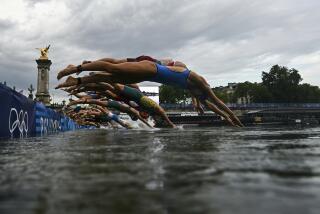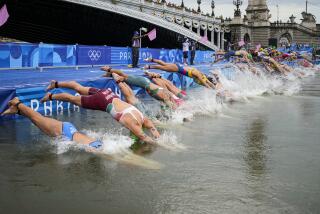Triathlons Had Humble Beginning : Friendly San Diego Races Led to Big-Time Sports Events
- Share via
SAN DIEGO — Scott Tinley recalls his first triathlon in 1976 as a chummy, low-key affair among 50 lifeguards, Navy SEALs and San Diego Track Club members.
Clad in Speedos and tennis shoes, the competitors ran along the shores of Fiesta Island, then pedaled their beat-up beach cruisers with fat, knobby tires and swam across Mission Bay. They finished by running along the beach for a total distance of about 15 miles.
“The first one was more of an obstacle course compared to the orderliness of events today,” Tinley said. “I’m following these guys because I didn’t know the course. The entry fee was 50 cents. . . . We were all just crazy guys racing for a case of beer.”
A decade later, Tinley has written a book, started his own line of triathlon apparel, endorsed athletic equipment and, in 1985, was named Triathlon magazine’s Triathlete of the Year. He said he hopes to make enough money as a professional triathlete to comfortably retire within the next several years.
Tinley, 29, of Del Mar, and Dave Scott, 32, of Davis, Calif., are two of the sport’s dominant figures. They are expected to duel Saturday for the $12,000 first prize in the 10th Ironman Triathlon Championships in Hawaii.
The popularity of the Ironman, the sport’s premier event, is perhaps the best example of how triathlons have evolved from the ultimate challenge for a handful of fitness fanatics to a diversion for middle-aged jocks going through mid-life crises.
In 1978, 15 people paid $3 apiece to compete in the first Ironman. For the 12 who survived the 2.4-mile swim, 112-mile bike ride and 26.2-mile run in the steaming Hawaiian heat, simply crossing the finish line was reward enough. There was not even a trophy for first place.
When Bob Babbitt competed in the 1980 Ironman, the Mission Valley resident brought a back pack, a sleeping bag and a change of clothing to Hawaii because he thought it would take him overnight to complete the 140-mile race. In contrast to today’s diet-conscious triathletes, Babbitt consumed a Big Mac, french fries, a Coke and a snow cone during the bicycle leg.
“The early people were more adventurers,” said Babbitt, 35, editor of Running and Triathlon News. “They were trying to see how far they could go. Everybody was out playing. Nobody took it seriously.”
John Collins, 50, a retired Navy captain now living in Coronado, has watched the sport go through drastic change since he organized the first Ironman race eight years ago.
“It was approached in the beginning as a totally outrageous event, a little bit like Hollywood celebrity pie-throwing,” Collins said. “It began as the ultimate endurance sport, not a sprint.”
In last year’s Ironman, Tinley shattered the course record by finishing in 8 hours, 50 minutes, 54 seconds. About 1,200 triathletes--nearly 200 from California--have paid the $100 entry fee to compete this year. Most entrants were required to meet a qualifying time for each age division to become eligible for the race.
For the first time, this year’s top finishers will be awarded prize money--$85,000 overall and $12,000 each to the top male and female competitors.
To get an edge, triathletes spend thousands of dollars on sophisticated equipment such as high-tech bicycles, aerodynamic helmets and sleek, one-piece triathlete suits. They keep track of calories and carbohydrates, and supplement countless hours of triathlon training with weightlifting programs.
Three-fourths of the athletes who now compete in triathlons are men between the ages of 25 and 45, according to statistics compiled by the United States Triathlon Series.
What began more than a decade ago in San Diego as an intimate affair among happy-go-lucky friends has developed into a worldwide sport with races in France, Australia and Japan. More than 1 million people now compete in triathlons, and there is talk of the sport becoming an Olympic event in 1992.
“I knew it would get bigger,” Tinley said. “But I had no idea it would get this big.”
Through it all, San Diego has remained the triathlon capital of the world.
For two years, the fraudulent La Jolla investment firm J. David & Co. supported about 10 top triathletes here, including Tinley, by paying monthly stipends ranging from $1,000 to $1,500. Team J. David stayed in some of the world’s finest hotels and traveled with an entourage that included a masseuse, a bicycle mechanic and swimming and running coaches.
The world’s first organized triathlon was put on by the San Diego Track Club in 1974 on Fiesta Island, according to Collins. A year later, the Optimist Club of Coronado ran the Sports Fiesta Triathlon, which became the world’s longest continuous event of its kind until last year, when liability problems and security concerns at North Island Naval Air Station put an end to the race.
The USTS circuit began in San Diego and has steadily grown into an annual 13-city tour. Last month’s stop in Solana Beach attracted 2,300 competitors and was fully booked three months in advance.
But the surge in popularity has caused triathlons to lose some of the camaraderie that initially attracted San Diegans to the sport in the 1970s.
“One thing I liked was when you knew everybody who did it,” said Jack Wilson, a San Diego airline pilot. “They were quaint and I loved the experience. But you can’t stand still.”
Wilson said triathletes have emerged as a large social club in San Diego, where the climate and warm ocean temperatures allow running, cycling and swimming enthusiasts to compete year-round.
“I know a lot of people think it is a yuppie sport,” Wilson said. “Even in spite of all that, it is still a neat, neat sport. It’s trendy no doubt, but it’s a real healthy addiction.
“I think it’s grown in a great way. There are these triathlons in towns I can’t even pronounce, in every state of the Union and in all European countries. It’s really turning on.”
Wilson, who plans to celebrate his 50th birthday this year by running his 50th marathon with 50 close friends, says complaints among old-timers that the sport has grown too fast are nothing but “sour grapes.”
He said: “I remember when we used to hunt deer in Sorrento Valley and catch lobster in the cove (La Jolla Cove, that is). You’ll hear those complaints from anybody who gets old.”
The most frequently heard criticism about triathlons today is that professionals have ruined the spirit of the sport by accusing each other of cheating on the bicycle rides, by drafting to get an unfair advantage. Drafting is when a rider conserves his energy by riding closely behind another cyclist, letting the competitor break the wind.
Others have been angered by top-flight competitors who have dropped out of triathlons if they are not in a position to win prize money.
“In 1980, we were not racing for money, we were racing for grins or beers,” Babbitt said. “We never thought of dropping out.”
Collins, who is visiting Hawaii this week to watch the race he started, said “strange things happened” when money and fame hit the triathlon circuit.
“Anyone who does this professionally has got to have the world’s largest ego,” Collins said. “Those egos must clash. That’s where a lot of the fireworks come from. . . .
“Some of the larger names in this business have teed me off. If they’re not going to win, they drop back and wave and smile. That’s not what they are being paid to do.”
However, both Babbitt and Collins agreed that, with few exceptions, triathlons still retain much of the flavor that made them so popular in the beginning.
“There is a real sports movement there that brings people in at all levels,” said Collins, director of engineering at Hydro Products in Sorrento Valley. “It has really extended the view of what the human body can do.”
To ensure that amateur athletes continue to compete in triathlons, Collins said, he turned over the Ironman to race officials after stipulating that space must always be reserved for the “common people.”
Thus, the Ironman holds a lottery each year for athletes who cannot qualify for the race.
Professional triathletes, meanwhile, are banking on reaping the kind of financial rewards offered on the tennis and golf circuits.
Tinley said triathlons have become a way of life. He said he spends 50 hours a week in training, plus 25 hours dealing with sponsors and running his own business.
“I guess I still do enjoy it,” Tinley said. “There are times when it becomes a real pain, but all I have to do is think of what else I could be doing, like sitting indoors shuffling papers.”


